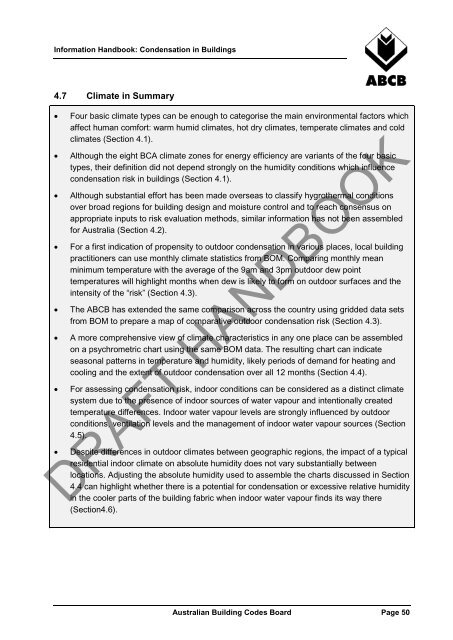Condensation in Buildings - Australian Building Codes Board
Condensation in Buildings - Australian Building Codes Board
Condensation in Buildings - Australian Building Codes Board
Create successful ePaper yourself
Turn your PDF publications into a flip-book with our unique Google optimized e-Paper software.
Information Handbook: <strong>Condensation</strong> <strong>in</strong> Build<strong>in</strong>gs<br />
4.7 Climate <strong>in</strong> Summary<br />
• Four basic climate types can be enough to categorise the ma<strong>in</strong> environmental factors which<br />
affect human comfort: warm humid climates, hot dry climates, temperate climates and cold<br />
climates (Section 4.1).<br />
• Although the eight BCA climate zones for energy efficiency are variants of the four basic<br />
types, their def<strong>in</strong>ition did not depend strongly on the humidity conditions which <strong>in</strong>fluence<br />
condensation risk <strong>in</strong> build<strong>in</strong>gs (Section 4.1).<br />
• Although substantial effort has been made overseas to classify hygrothermal conditions<br />
over broad regions for build<strong>in</strong>g design and moisture control and to reach consensus on<br />
appropriate <strong>in</strong>puts to risk evaluation methods, similar <strong>in</strong>formation has not been assembled<br />
for Australia (Section 4.2).<br />
• For a first <strong>in</strong>dication of propensity to outdoor condensation <strong>in</strong> various places, local build<strong>in</strong>g<br />
practitioners can use monthly climate statistics from BOM. Compar<strong>in</strong>g monthly mean<br />
m<strong>in</strong>imum temperature with the average of the 9am and 3pm outdoor dew po<strong>in</strong>t<br />
temperatures will highlight months when dew is likely to form on outdoor surfaces and the<br />
<strong>in</strong>tensity of the “risk” (Section 4.3).<br />
• The ABCB has extended the same comparison across the country us<strong>in</strong>g gridded data sets<br />
from BOM to prepare a map of comparative outdoor condensation risk (Section 4.3).<br />
• A more comprehensive view of climate characteristics <strong>in</strong> any one place can be assembled<br />
on a psychrometric chart us<strong>in</strong>g the same BOM data. The result<strong>in</strong>g chart can <strong>in</strong>dicate<br />
seasonal patterns <strong>in</strong> temperature and humidity, likely periods of demand for heat<strong>in</strong>g and<br />
cool<strong>in</strong>g and the extent of outdoor condensation over all 12 months (Section 4.4).<br />
• For assess<strong>in</strong>g condensation risk, <strong>in</strong>door conditions can be considered as a dist<strong>in</strong>ct climate<br />
system due to the presence of <strong>in</strong>door sources of water vapour and <strong>in</strong>tentionally created<br />
temperature differences. Indoor water vapour levels are strongly <strong>in</strong>fluenced by outdoor<br />
conditions, ventilation levels and the management of <strong>in</strong>door water vapour sources (Section<br />
4.5).<br />
• Despite differences <strong>in</strong> outdoor climates between geographic regions, the impact of a typical<br />
residential <strong>in</strong>door climate on absolute humidity does not vary substantially between<br />
locations. Adjust<strong>in</strong>g the absolute humidity used to assemble the charts discussed <strong>in</strong> Section<br />
4.4 can highlight whether there is a potential for condensation or excessive relative humidity<br />
<strong>in</strong> the cooler parts of the build<strong>in</strong>g fabric when <strong>in</strong>door water vapour f<strong>in</strong>ds its way there<br />
(Section4.6).<br />
DRAFT HANDBOOK<br />
<strong>Australian</strong> Build<strong>in</strong>g <strong>Codes</strong> <strong>Board</strong> Page 50
















